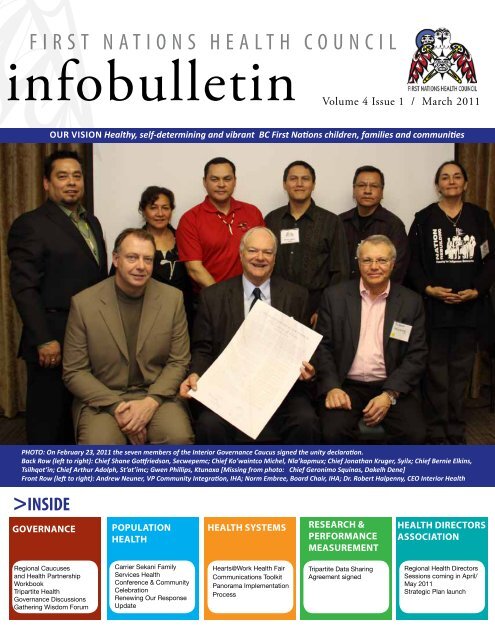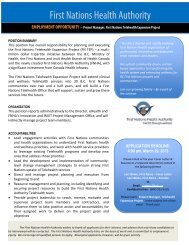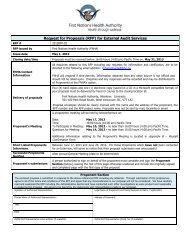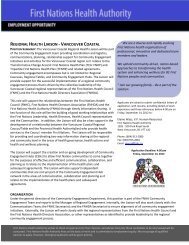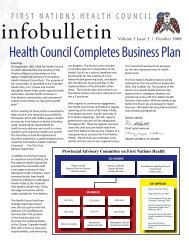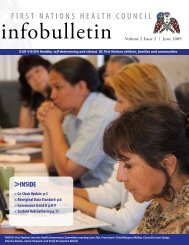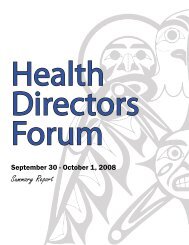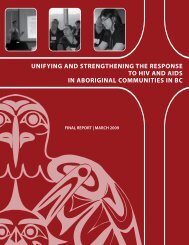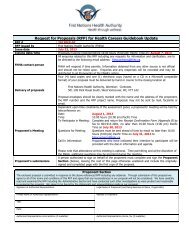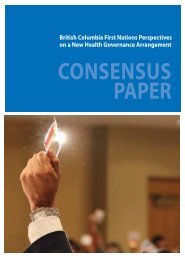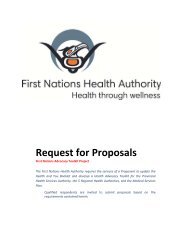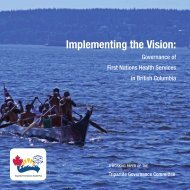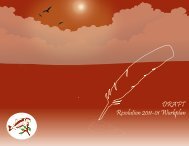March 2011 - First Nations Health Council
March 2011 - First Nations Health Council
March 2011 - First Nations Health Council
Create successful ePaper yourself
Turn your PDF publications into a flip-book with our unique Google optimized e-Paper software.
<strong>First</strong> <strong>Nations</strong> <strong>Health</strong> <strong>Council</strong> | <strong>March</strong> <strong>2011</strong> Infobulletin | Page 3Governance<strong>Health</strong> <strong>Council</strong> Update <strong>March</strong> <strong>2011</strong>Regional Caucuses and <strong>Health</strong>Partnership WorkbookThe <strong>First</strong> <strong>Nations</strong> <strong>Health</strong> <strong>Council</strong> launcheda <strong>Health</strong> Partnership Workbook in Januaryof this year- to seek your feedback anddirection for the development of a newhealth partnership between BC <strong>First</strong> <strong>Nations</strong>and provincial and federal governments.We heard your message loud and clear.<strong>First</strong> <strong>Nations</strong> want the <strong>First</strong> <strong>Nations</strong> <strong>Health</strong>Authority to be community-driven andNation-based. The <strong>First</strong> <strong>Nations</strong> <strong>Health</strong><strong>Council</strong> wants to work with you to develop aconsensus on what this direction means forthe authority and structure of our new <strong>Health</strong>Authority. This new health partnershipwill include a regional health transfer -building upon the successful communityhealth transfers by transferring the PacificRegion of <strong>First</strong> <strong>Nations</strong> Inuit <strong>Health</strong> to thenew <strong>First</strong> <strong>Nations</strong> <strong>Health</strong> Authority. <strong>First</strong><strong>Nations</strong> will engage the Province and theirregional health authorities to influence theirdecisions. The provincial health budget ishalf the budget of the entire province!In the <strong>Health</strong> Partnership Workbook, wereflect back what we heard from you duringpast Regional caucus meetings and we askyou to confirm what we have heard and togive us direction. The <strong>First</strong> <strong>Nations</strong> <strong>Health</strong><strong>Council</strong> needs your advice on the roles andresponsibilities of the <strong>First</strong> <strong>Nations</strong> <strong>Health</strong>Authority, <strong>First</strong> <strong>Nations</strong> <strong>Health</strong> <strong>Council</strong>, and<strong>First</strong> <strong>Nations</strong> <strong>Health</strong> Directors Association.The Workbook asks you, “Did we captureYour Voicewhat you have said?” “Is there anythingmissing?”For each region, the <strong>First</strong> <strong>Nations</strong> <strong>Health</strong><strong>Council</strong> will summarize your feedbackand direction from the Workbook into fiveregional summary documents. RegionalCaucuses will then be asked to confirm theirSummary Document. When completed,the five regional summary documents willbe merged into one single province-wideconsensus document. This consensusdocument will be put forward for approvalat the 4th Annual Gathering Wisdom Forumheld May 24-27th in Richmond BC. ThisConsensus Document will guide and directthe work of the <strong>First</strong> <strong>Nations</strong> <strong>Health</strong> <strong>Council</strong>in creating the <strong>First</strong> <strong>Nations</strong> <strong>Health</strong> Authority.Regional caucus sessions are underway, andadditional meetings are being scheduled inall of the regions. In partnership with the<strong>First</strong> <strong>Nations</strong> <strong>Health</strong> Directors Associationand government partners as invited - wehave presented this <strong>Health</strong> PartnershipWorkbook in your regions. Please visitthe FNHC website for the dates for thenext caucus meeting within your region:http://www.fnhc.ca/index.php/health_governance/regional_caucuses/The <strong>First</strong> <strong>Nations</strong> <strong>Health</strong> <strong>Council</strong> needsyour support and direction. Pleaseencourage your Chiefs, leaders, and <strong>Health</strong>Directors and interested citizens to fill outthe Workbook and provide your valuablefeedback. The deadline for workbookfeedback is <strong>March</strong> 29th, <strong>2011</strong>. In order toYourVoice<strong>Health</strong> Partnership Workbook for BC <strong>First</strong> <strong>Nations</strong>have you name included in the early birddraw, please send your workbook no laterthan: <strong>March</strong> 15th, <strong>2011</strong>. Prizes will bedrawn on <strong>March</strong> 30th, <strong>2011</strong>. Prizes include:• Early bird prize: IPOD Touch• 5 regional prizes: Nintendo Wiigaming consoles• Grand Prize: 32 gb iPADAn online version of the <strong>Health</strong> PartnershipWorkbook, as well as a number of relateddocuments are available on the FNHCwebsite at: http://www.fnhc.ca/
<strong>First</strong> <strong>Nations</strong> <strong>Health</strong> <strong>Council</strong> | <strong>March</strong> <strong>2011</strong> Infobulletin | Page 4Governance<strong>Health</strong> <strong>Council</strong> Update <strong>March</strong> <strong>2011</strong>Tripartite DiscussionsAs directed by Chiefs, the FNHC isoverseeing discussions with federal andprovincial partners to implement thecommitments described in the Tripartite<strong>First</strong> <strong>Nations</strong> <strong>Health</strong> Plan and the Basisfor a Framework Agreement on <strong>Health</strong>Governance to establish a new healthpartnership and a regional health transfer.This work is incredibly complex. It is notpossible to set out all of the work in oneagreement. Therefore, Canada, the Provinceof BC, and the <strong>First</strong> <strong>Nations</strong> <strong>Health</strong> <strong>Council</strong>have agreed to manage change through anumber of documents and agreements,developed over several years. Takentogether, these documents will describethe new health governance arrangement.None of these agreements will impact anyof the title, rights, or treaty rights of any <strong>First</strong>Nation in BC - these agreements all relateto a new administrative arrangement for thedelivery of health services to <strong>First</strong> <strong>Nations</strong>in BC. These documents and agreementsinclude:Framework Agreement: This is a legalcontract setting out binding commitmentsfor the transfer the <strong>First</strong> <strong>Nations</strong> and InuitHeath Pacific Region to a <strong>First</strong> <strong>Nations</strong><strong>Health</strong> Authority and lock down the federalfunding commitments before any changein government. This high-level legalagreement guarantees that the Partieswill honour each existing health transferagreement as-is, and that <strong>Health</strong> Canadawill retain its fiduciary duty. The timeline forcompleting this agreement is early <strong>2011</strong>.<strong>Health</strong> Partnership Accord: This will bea political accord that sets out a sharedvision and expected outcomes for a longstanding,enduring partnership in supportof <strong>First</strong> <strong>Nations</strong> health. At the core of thisnew partnership is reciprocal accountability- each Party recognizes the importantcontribution of the other and re-affirmstheir mutual commitment to be responsibleto each other for fulfilling their respectiveobligations. This accord sets out a sharedvision, reciprocal accountability andcommitments and processes for workingtogether, ensuring the effectiveness ofour relationship and the effectiveness ofour outcomes. This accord will supportrelationships at all levels, including bysupporting local relationships betweenhealth authorities and <strong>First</strong> <strong>Nations</strong>. Thetimeline for completing this agreement isearly <strong>2011</strong>.Implementation Plan: This is a detailed,multi-year plan, including activities, rolesand responsibilities of the Parties, forimplementing the Framework Agreementand <strong>Health</strong> Partnership Agreement,including the specific program transfers totake place over a number of years. Thetimeline for completing this plan is to bedetermined, but will not be in the short-term(over the next year or two).Sub-Agreements: Several subject-specificagreements will be developed to addresstechnical issues not set out in detail in theFramework Agreement. These technicalissues include: information managementand technology; human resources; financialcommitments; office space; and, records.The timeline for completing this plan is tobe determined, but will not be in the shortterm(over the next year or two).Structure of the <strong>First</strong> <strong>Nations</strong> <strong>Health</strong>Authority: A <strong>First</strong> <strong>Nations</strong> <strong>Health</strong> Authoritywill be created to deliver the programscurrently delivered by <strong>First</strong> <strong>Nations</strong> and Inuit<strong>Health</strong>-BC Region. This new organizationneeds to be legally established, and haveclearly described by-laws, accountabilitiesand structure. The timeline for establishingthe structure of the <strong>First</strong> <strong>Nations</strong> <strong>Health</strong>Authority will depend on <strong>First</strong> <strong>Nations</strong> - <strong>First</strong><strong>Nations</strong> will tell us how much time we needto take to develop this structure, and buildsupport and understanding for it.Legislation: Federal and/or provinciallegislation may be developed to support theFramework Agreement, <strong>Health</strong> PartnershipAgreement, and the role and authoritiesof the <strong>First</strong> <strong>Nations</strong> <strong>Health</strong> Authority. Thepurpose of this legislation will be to ensurethat the <strong>First</strong> <strong>Nations</strong> <strong>Health</strong> Authorityhas the standing, authority, powers, andaccountabilities to effect meaningfulchange in <strong>First</strong> <strong>Nations</strong> health at thecommunity level and engage with partnersat the provincial and national levels. Thetimeline for completing potential legislationis to be determined, and will be linked withthe timelines for the structure of the <strong>First</strong><strong>Nations</strong> <strong>Health</strong> Authority above.Currently, the FNHC is engaged indiscussions with <strong>Health</strong> Canada and theBC Ministry of <strong>Health</strong> Services on the legalFramework Agreement and the <strong>Health</strong>Partnership Agreement. We hope to finalizethe technical work on these documents by<strong>March</strong> <strong>2011</strong>, and then focus on the politicalprocesses required for approval of thesedocuments.Your feedback into the <strong>Health</strong> PartnershipWorkbook is key to this process - you willgive us valuable advice and guidance forthe development and approval of all of thedocuments described above.Up-to-date information on these tripartitediscussions will be provided to <strong>First</strong> <strong>Nations</strong>by FNHC members at upcoming regionalcaucus sessions.Relationships and SocialDeterminantsThe FNHC recognizes the need to workwith partner organizations to improve thequality of life for <strong>First</strong> <strong>Nations</strong> in BC. Weare committed to working with otherson the social determinants of health -improving the conditions in which <strong>First</strong><strong>Nations</strong> people in BC are born, grow, live,work and age. There are a large number of<strong>First</strong> <strong>Nations</strong> and Aboriginal organizationsin BC that are working on the same issues- from the perspective of their mandates ineducation; child care; child welfare; socialdevelopment; justice; and many others.The FNHC is undertaking to host a planningmeeting amongst all interested social <strong>First</strong><strong>Nations</strong> and Aboriginal organizations beforethe end of the fiscal year. The purpose ofthis meeting is to provide the opportunity forthese organizations to begin collaborations,and receive advice and feedback, on newand ongoing projects, as well as to start theprocess for systemic change in the way wework together in support of <strong>First</strong> <strong>Nations</strong> inBC.
<strong>First</strong> <strong>Nations</strong> <strong>Health</strong> <strong>Council</strong> | <strong>March</strong> <strong>2011</strong> Infobulletin | Page 5Governance<strong>Health</strong> <strong>Council</strong> Update <strong>March</strong> <strong>2011</strong>Administrative and Policy IssuesIn closing, the FNHC is pleased tointroduce our new Executive Director,Steve Smith. Steve is Daklawaidi (Eagleclan) of the Champagne & Aishihik <strong>First</strong><strong>Nations</strong>. Steve has over 16 years ofexperience working with <strong>First</strong> <strong>Nations</strong>.His involvement has included extensivework with the Champagne and Aishihik<strong>First</strong> <strong>Nations</strong> where he served two-termsas Deputy Chief, as well as serving asa Senior Policy Advisor in his role asDirector of Secretariat for 4 years. Prior tojoining the FNHC, Steve was the Directorof <strong>First</strong> <strong>Nations</strong>’ Initiatives at YukonCollege where he acted as Senior Advisorto the President and senior managementon <strong>First</strong> <strong>Nations</strong>. Steve presently servesas Secretary to the Board of the YukonIndian Development Corporation. Stevehas recently completed the Masters ofBusiness Administration program at RoyalRoads University. He is married and has 3children. The FNHC Executive Directorprovides administrative and managementleadership for the requirements of theFNHC on a day to day basis.Recently, the FNHC has developed anumber of plans and policies to guideand provide discipline to its efforts.This includes: a meeting policy (for bothinternal and external FNHC meetings); acommunications plan; and a workplan(2010-2012).Thank you for taking the time to reviewthis report. Please do not hesitate tocontact us with any questions.Sincerely,FNHC Chair and Deputy Chair on behalfof the FNHCInterior <strong>Nations</strong> Sign Unity DeclarationOn February 23, <strong>2011</strong> the seven members of the Interior Governance Caucus signed theUnity Declaration created exactly a year ago. The declaration confirms the commitmentof the 7 Interior <strong>Nations</strong> to continue to work together in a Nation to Nation model in theimplementation of the Tripartite <strong>First</strong> <strong>Nations</strong> <strong>Health</strong> Plan.This declaration follows a long history among interior <strong>Nations</strong> of unified leadership, andof seeking common goals for their communities. Over 100 years ago, Chiefs from theSecwepemc, Syilx and Nla’kapmux nations signed the Sir Wilfred Memorial declarationat Spence’s Bridge. The declaration committed the <strong>Nations</strong> to work together to resolveoutstanding rights and title issues in their respective territories. This more recent <strong>Health</strong>Unity Declaration was signed by the seven members of the Interior <strong>Health</strong> GovernanceCommittee. To read the declaration in full please visit our website (www.fnhc.ca) under theheading: <strong>Health</strong> Governance > Regional Caucuses > Interior Regional Caucus.Unity Declaration was signed by:Chief Shane Gottfriedson, Secwepemc; Chief Ko’waintco Michel, Nla’kapmux; Chief JonathanKruger, Syilx; Chief Bernie Elkins, Tsilhqot’in; Chief Arthur Adolph, St’at’imc; Gwen Phillips,Ktunaxa; and, Chief Geronimo Squinas, Dakelh DeneUpcoming MeetingsRegional Caucus Sessions- Next Steps and Gathering Wisdom IVThe next round of regional caucus sessions take place between April 21st and May 5th andcall for full caucus participation. The <strong>First</strong> <strong>Nations</strong> <strong>Health</strong> <strong>Council</strong> technical team is in theprocess of bringing together all of the feedback gathered through the <strong>Health</strong> Partnershipworkbook, past regional caucus meetings, regional break-out sessions at GatheringWisdom, and other documents prepared by the regions (ie. Interior Unity Declaration). Thisinformation will be synthesized into a series of regional summary documents one for eachthe North, Interior, Fraser, Vancouver Island and Vancouver Coastal.At the upcoming caucus sessions, caucus members will receive an information packagewhich will include a regional summary paper. Caucus members will be asked to providefeedback on, and confirm, their region’s summary document. These regional summarypapers will form the basis for a provincial consensus paper that will be brought forward forratification by resolution at the fourth annual Gathering Wisdom Forum May 24-27, <strong>2011</strong> inRichmond, BC.At the sessions, Caucus members will also have the opportunity to review the FrameworkAgreement on <strong>First</strong> <strong>Nations</strong> <strong>Health</strong>. The Framework Agreement outlines a new administrativearrangement for the transfer of the Pacific Region FNIH offices to <strong>First</strong> <strong>Nations</strong> control. Inaddition to being available at the next round of caucus sessions, the Framework Agreementwill be distributed with a summary document and legal opinion to all Chiefs in BC.
<strong>First</strong> <strong>Nations</strong> <strong>Health</strong> <strong>Council</strong> | <strong>March</strong> <strong>2011</strong> Infobulletin | Page 6<strong>First</strong> <strong>Nations</strong> <strong>Health</strong> Directors Association<strong>Health</strong> Directors Launch Regional DiscussionsFarewell to Jim Adams, former <strong>First</strong><strong>Nations</strong> <strong>Health</strong> Directors Association Vice-President and Interior region appointment.We thank you for your commitment tothe Association and wish you well in yourfuture endeavors. Currently, there is onevacancy on the FNHDA Board, whichincludes these two regions.The <strong>First</strong> <strong>Nations</strong> <strong>Health</strong> DirectorsAssociation is pleased to welcomeDeborah Schwartz as the ExecutiveDirector, <strong>First</strong> <strong>Nations</strong> <strong>Health</strong> DirectorsAssociation. Deborah brings to this rolea dynamic combination of government,community and health service deliveryexperience. We are pleased to haveDeborah back in BC and once againworking with BC <strong>First</strong> <strong>Nations</strong>.The FNHDA is excited to report thatwe have completed work on criticalfoundational documents which will guideand govern work going forward. The <strong>First</strong><strong>Nations</strong> <strong>Health</strong> Directors AssociationStrategic Plan (2010-2013) and detailedworkplan were approved and acceptedby the Board on January 15, <strong>2011</strong>. TheStrategic Plan addresses issues withregard to the support of <strong>First</strong> <strong>Nations</strong>health directors and mandated healthorganizations, technical advice andadvocacy, as well as establishing <strong>First</strong><strong>Nations</strong> <strong>Health</strong> governance.The FNHDA also completed their Terms ofReference (January <strong>2011</strong>), which outlinesthe Boards role, responsibilities andaccountability mechanisms.In addition to creating foundationaldocuments, the Association has beenanalyzing the work of other Associations.The national <strong>First</strong> <strong>Nations</strong> <strong>Health</strong> ManagersAssociation has provide an excellentmodel, in particular they have providedguidance through their competencyframework. D.Laurette Bloomquist,FNHDA Vice President, is a member ofthis national association.President Judith Gohn and Vice PresidentLaurette Bloomquist, along with otherBoard of Directors, have also beenbusy strengthening relationships withCommunity Engagement Hubs, the <strong>First</strong><strong>Nations</strong> <strong>Health</strong> <strong>Council</strong>, and they havebeen actively spreading the word aboutthis growing association.The FNHDA membership drive waslaunched in September 2010, and hassteadily been growing momentum! Manyapplications have been received for Fulland Association Membership from healthprofessionals across the province. Themembership committee would like to thankeveryone for their patience, as we continueto process new applications. Currently thereare 42 Full, and 19 Association Members(total 61), with several applications currentlyunder review. We continue to welcome newmembers and associate members.<strong>Health</strong> Directors Regional SessionsCurrent and future members of the <strong>First</strong> <strong>Nations</strong> <strong>Health</strong> Directors Association areinvited to participate in regional health directors meetings coming soon.Interior – April 19 & 20th – Kamloops <strong>Health</strong> Directors sessionVancouver Island – April 27 & 28th – Parksville <strong>Health</strong> Directors sessionVancouver Coastal – April 27th – Vancouver Hotel Pinnacle <strong>Health</strong> Directors sessionNorth – May 3rd – Prince George <strong>Health</strong> Directors sessionFraser – May 4th – Chilliwack <strong>Health</strong> Directors sessionPurposeThe purpose of the regional health directors sessions will be to work with <strong>Health</strong>Directors in each region to:• Discuss the roles of FNHDA, FNHS, FNHC, Community Engagement Hubs,Caucuses, and how they all work together;• Present the FNHDA Strategic Plan for membership ratification; and discuss otherkey directives [ie. Terms of Reference, Memorandum of Understanding(s)];• Gather information on regional health issues and needs and process of bringing itto <strong>Health</strong> Directors table and then to <strong>First</strong> <strong>Nations</strong> <strong>Health</strong> Society;• Develop the program for the <strong>Health</strong> Directors portion of the Gathering Wisdomconference• Identify subject champions among the health directors who are willing to sit onprovincial committees;• Complete the <strong>First</strong> <strong>Nations</strong> <strong>Health</strong> Society Communications Survey.FNHDA Board of Directors:North: Hertha Holland, DoreenL’Hirondelle, Aileen PrinceInterior: Patrick Lulua, JackiMcPherson, One VacancyVancouver Island: Georgia Cook,Nora Martin, Judith Gohn.Vancouver Coastal: LauretteBloomquist, Allison Twiss.The Association is pleased withthe commitment and dedicationdemonstrated by the founding directorsand evidenced through the overwhelmingsupport from <strong>First</strong> <strong>Nations</strong> <strong>Health</strong> Directorsin BC. We look forward to getting out intothe regions in April and May to meet withour membership and to continue work todevelop our Association.In closing, the Directors of the Associationare excited and well prepared to begin theimportant work that will take us into our2nd year of operation!
<strong>First</strong> <strong>Nations</strong> <strong>Health</strong> <strong>Council</strong> | <strong>March</strong> <strong>2011</strong> Infobulletin | Page 7<strong>Health</strong> Actions<strong>Health</strong> Actions: “Where the Rubber hits the Road ”You may be asking yourself: What is meantwhen we talk about ‘<strong>Health</strong> Actions’?<strong>Health</strong> Actions can be best described as:systems transformation; or improving thecurrent health system (hospitals, clinics, andprograms and services) to better serve <strong>First</strong><strong>Nations</strong> people. It can also be describedas the place in the Tripartite <strong>First</strong> <strong>Nations</strong><strong>Health</strong> Plan where the rubber hits the road.Primary andPublic Careresearch &surveillanceThe Tripartite <strong>First</strong> <strong>Nations</strong> <strong>Health</strong> Plansigned in 2007 calls for some pretty farreachingchanges to the health system. Tryas we might, <strong>First</strong> <strong>Nations</strong> alone cannotmake these changes happen. The provincialgovernment (and their regional healthauthorities) have a responsibility to providehealthcare to all British Columbians. Inaddition, the federal government currentlyprovides some health care services onreservethrough transfer agreements ordirect services. The task of <strong>Health</strong> Actions isto transform and coordinate these servicesto best meet community and individualhealth care needs.maternal andchild healthMENTAL<strong>Health</strong> &addictionsehealthhealthhumanresourcesTo begin making these important changestoday, the Federal government throughthe <strong>First</strong> <strong>Nations</strong> and Inuit <strong>Health</strong> Branch,the Provincial government and the <strong>First</strong><strong>Nations</strong> <strong>Health</strong> <strong>Council</strong> have commited tosome ground rules. These ground rules,called Strategic Principles for <strong>Health</strong> ActionsApproach (see below) will guide systemsimprovements called for through the <strong>Health</strong>Plans.healthplanningThe diagram above illustrates the strategic approach to systems transformation. In futureissues of this bulletin we will provide in-depth coverage of the collective work of BC, Canadaand <strong>First</strong> <strong>Nations</strong> in each of these areas.Strategic Principles for <strong>Health</strong> Actions ApproachThere are three fundamental principles that underpin the approach to addressing health actions from the TCA:FNHP and the TFNHP:1. The Tripartite partners will be at the table together to discuss transformation of health services that willbenefit the health of <strong>First</strong> <strong>Nations</strong> communities in a new collaborative way of working. This requires thatthe ‘decision-makers’ and those with responsibility and authority on all sides are at the table to inform,plan and make decisions about system change that is needed and to monitor the changes as they occur;2. <strong>First</strong> <strong>Nations</strong> will be at the table when making plans and decisions for all health actions that reflectsincreased <strong>First</strong> Nation decision-making in health at all levels from strategy and planning to implementationand service delivery; and3. ‘System transformation’ is the goal of all health actions work – services need to continue to change, adaptand improve so that they are more appropriate, accessible and effective for <strong>First</strong> <strong>Nations</strong>.
<strong>First</strong> <strong>Nations</strong> <strong>Health</strong> <strong>Council</strong> | <strong>March</strong> <strong>2011</strong> Infobulletin | Page 8Population <strong>Health</strong>Carrier Sekani Family Services Conference HighlightsDrugs themselves are not addictive renownedauthor, physician and academic Dr. Gabor Matetold a packed house of 350 delegates in PrinceGeorge. Speaking at the One Mind, One Body,One Spirit <strong>Health</strong> and Wellness conference Dr.Mate claimed that “If drugs were addictive, inand of themselves, anyone who ever tried themwould become an addict.” Why is it that somepeople can try drugs several times and thengive them up completely, while another personis literally hooked off the first hit?It is about a continuum of susceptibility, arguesDr. Mate. The pleasure centre’s in the brain thatgive us pleasure, that process feelings of loveand elation, are damaged in the brains of mostaddicts. These pleasure centre’s are createdand nurtured very early in life says Dr. Mate. Herecounts his own childhood to describe whatcan happen when a baby grows in a stressfulenvironment.I am both a survivor and a child of the Nazigenocide, having lived most of my first yearDr. Gabor Mate-In the Realm of Hungry Ghostsin Budapest under Nazi occupation. Nogreat powers of imagination are required tounderstand that in her state of mind, and underthe inhuman stresses she was facing daily, mymother was rarely up to the tender smiles andundivided attention a developing infant requiresto imprint a sense of security and unconditionallove in his mind. I learned early that I had towork for attention, to burden my mother as littleas possible and that my anxiety and pain werebest suppressed.Dr. Mate doesn’t buy the theory that addictsare actually genetically flawed. He feels thatthis theory actually lets society off the hookfrom looking at the root causes of addiction.If addiction is genetic then we don’t have tolook at the world that we live in, the effectsof social policies, and the political decisionsthat continue to disadvantage certain minoritygroups and thereby cause them more stress.Stress and pain he claims are the realpredispositions for addiction, not genetics.Across North America, the burden of addictionsfalls most heavily on <strong>First</strong> <strong>Nations</strong> people.Dr. Mate questions: What is it about the <strong>First</strong><strong>Nations</strong> experience that makes a people sosusceptible to being addicted to drugs andalcohol? “It is the historic and ongoing wrongsagainst <strong>First</strong> <strong>Nations</strong> people, economic, social,and spiritual, and the concomitant poverty andstress. Dislocation and high levels of abuse(physical, sexual, emotional and mental) arethe real root causes of addiction.” says Dr.Mate “When people are mistreated, stressed orabused, their brains don’t develop the way theyought to. It’s that simple. And unfortunately, myprofession, the medical profession, puts allthe emphasis on genetics rather than on theenvironment.”Dr. Mate treated people with addictions onthe downtown east side for 10 years. In hispractice he noticed that every single one of hisfemale clients, aboriginal and non-aboriginalhad at some point in their lives suffered sexualabuse. His male clients didn’t fare any better,and were universally victims of physical orsexual abuse. His clients used drugs in anattempt to be healthy, to fill the pleasurecentres in their brain that had been damagedas a result of the abuse. It is abuse in all forms,not drug addiction that our communities mustfirst grapple with, claims Dr. Mate. As muchas it hurts to admit, most families have beendirectly affected by sexual abuse. As commonthe abuse is, silence pervades. Dr. Mate’sadvice: Victims of abuse need compassion,not the judgment and ridicule that is too oftenheaped upon people struggling with addiction.Sheldon KennedyFormer NHL player Sheldon Kennedy (pictured below) illustrated the power of personalstories and held the crowd captive sharing his own story of abuse and addiction at theCarrier Sekani conference. Following Dr. Mate’s technical presentation on abuse andaddiction Mr. Kennedy’s story hit home in a whole different way. “I was from a town so smallthat we would bring Big Mac wrappers to show and tell” Mr. Kennedy quipped, warming upthe audience for his more serious take-home message. “The most important thing that avictim of abuse can do is to come out of that place of chaos, shame, and addiction whereso many victims get stuck. I decided to not be a victim anymore, to acknowledge that Iwasn’t dealt the best hand in life, but to take responsibility for how I lived my life and howmy actions affected others.”
<strong>First</strong> <strong>Nations</strong> <strong>Health</strong> <strong>Council</strong> | <strong>March</strong> <strong>2011</strong> Infobulletin | Page 9Population <strong>Health</strong>CSFS Bah’lats- A Feast to RememberYouth Profile:Lance George, Stellaten NationDr. Evan Adams (left); Lance George (right)Warner Adam, Executive Director- Carrier Sekani Family Services and deputy chair <strong>First</strong> <strong>Nations</strong> <strong>Health</strong><strong>Council</strong> honours Northern <strong>Health</strong> executives for their contribution to the carving project.Over 600 Carrier citizens and a handful ofdignitaries packed the Prince George CivicCentre for the Carrier Sekani Family ServicesAll Clans Bah’lats (Potlatch) on February 16,<strong>2011</strong>. Powerful displays of Carrier culturespoke to the health of Carrier traditional law.Entering the feast hall, clan chiefs seated theguests according to the four clans Likhtsemisyn(Beaver), Jilhtsehyn (Frog), Likhc’ibu (Bear),and Gilantin (Cariboo). Carrier people maintaina governance system commonly referred toas the Bah’lats or Potlatch. The Bah’lats isthe core economic, political, social, legal andspiritual institution of the Carrier people. Allformal business of the Bah’lats is conductedin an open and transparent environment whereclan members are witness to the transactionsthat occur. Witnesses commit to memory theproceedings of the Bah’lats, and hereditarychiefs in attendance recount the happeningsat future feasts in a manner informed byCarrier law.Once everyone was seated Lheidli T’ennehelder Frank Friedrick welcomed the guests tohis territory and set the stage for the All Clan’sprocession. During the procession, each ofthe 4 clans was drummed into the hall as agroup. The energy in the building was electricas the clans vied to dance the hardest, singthe loudest and bring forward the most moneyfor the drummers.Following dinner and acknowledgements allwere ready for the main event, the unveiling ofa new carving to be permanently displayed atUniversity Hospital in Prince George.“This carving is for all of us” said NathanTeegee, who lead the project on behalf ofCarrier Sekani. “For every one of our peoplewho visits the hospital and is far from home,the carving is a reminder that we all belonghere. For the doctors who walk through thedoor every day, it is a reminder that they arehere to serve everyone.”At 16 foot tall and 500 pounds the carvingis immense. Master carver Peter George,explains that the carving tells the story of theCarrier clans, and that the hands picturedthroughout the carving represent the 200people who lent a hand in the carving process.Cathy Ulrich, Chief Executive Officer ofNorthern <strong>Health</strong> Authority was on hand forthe unveiling, “I think for a long time we haveworked in isolation from the <strong>First</strong> <strong>Nations</strong>people in this territory, this [carving] is a realrepresentation of a new partnership and a newway of working together” said Ulrich “…wehave lots to learn from the Aboriginal people ofthis area, we can learn from them and we candeliver better health care services if we work inpartnership.”Visit our YouTube channel to see morepictures from this event:www.youtube.com/fnhealthcouncil“I come from a good family, my parents raised mewell and I never saw them drink, they quit beforeI was born. My parents are a big influence onme and they practice our culture. I love singingand drumming, and I want to learn more of ourlanguage. The best part of the conference has beenlearning about all of this health information that Ihad never heard before. I think a lot of teenagersdrink and party around with their friends becausethey feel like there is nothing to do. If we had moredaytime activities that didn’t involve drugs andalcohol I think that would help a lot.”Photo (above): Master carver Peter George andapprentice Clayton Gauthier unveil the new carvingto be permanently housed in the atrium at UniversityHospital of Northern BC. (below) Drummers sing inthe 4 clans during the Bah’lats.
<strong>First</strong> <strong>Nations</strong> <strong>Health</strong> <strong>Council</strong> | <strong>March</strong> <strong>2011</strong> Infobulletin | Page 10Population <strong>Health</strong>Renewing our Response Update:Renewing Our Response (RoR) met onJanuary 13th & 14th. Once again, Seekand Treat for Optimal Prevention of HIV(STOP), previously mentioned in the lastupdate, was a focal point for our discussion.While it appears as though movementin STOP is slow, there is progress beingmade – both Vancouver Native <strong>Health</strong>Society (VNHS) and Positive Living North(PLN), members of RoR, as well as othercommunity organizations, have receivedpositions through STOP to help with itsimplementation in Prince George andVancouver’s Downtown Eastside. RoR hasalso just received the Aboriginal CommunityEngagement Report, completed by Dr.Denielle Elliott and funded by the Provincial<strong>Health</strong> Services Authority, which has beensubmitted to PHSA and will be taken tothe STOP Leadership Committee for itsuse in guiding STOP activities to ensurethe needs of Aboriginal people are met.RoR agrees that is important to continue tovoice the need for community involvementin the rolling out of STOP initiatives, afeeling echoed by community organizationsthroughout the province. RoR will bemeeting on February 11th to strategize theirPlan of Action based on Dr. Elliott’s report.Mark Gilbert and Travis Hottes from theBCCDC presented a new sexual healthinitiative being developed by the BCCDC– BC Online Sexual <strong>Health</strong> Services.This initiative is still in its early stages of“RoR agrees that is importantto continue to voice the need forcommunity involvement in the rollingout of STOP initiatives, a feelingechoed by community organizationsthroughout the province. ”development; please visit their websitefor more information and updates: http://bclovebytes.wordpress.com/.RoR has agreed to collaborate with theresearch team on a CIHR funded Programof Research entitled Migration, Mobility,<strong>Health</strong> and <strong>Health</strong> Equity: Addressing theDisparities in HIV Prevention, Treatment, andCare Experienced by Aboriginal People inCanada. The theory behind this research isthat migration and mobility affect the healthoutcomes of Aboriginal people in relationto HIV. The program will be conducted incities in BC, Saskatchewan, Ontario, NewBrunswick, and hopefully the NorthwestTerritories. This will be a fantastic researchprogram and we are very happy to be ableto contribute to the work that will be done inany way we can.Two events that RoR will be hosting inthe short term are the Educator’s Forum,being done in partnership with Pacific AIDSNetwork on <strong>March</strong> 1st & 2nd, and the 1stAnnual APHA Forum on <strong>March</strong> 28th and29th. Registration and Scholarships forAboriginal People Living with HIV/AIDS(APHAs) to the APHA forum are open untilFebruary 28th. Please visit our website formore details.The Community Needs Assessment Reportmentioned in the previous update has beendelayed in being uploaded onto the website.The document has been reviewed by RoRand will be edited and the final versionwill be available in late January or earlyFebruary. Thank you for your patience.For more information on RoR, pleasevisit our website (renewingourresponse.ca) or contact Heidi Standeven at:hstandeven@red-road.org.
<strong>First</strong> <strong>Nations</strong> <strong>Health</strong> <strong>Council</strong> | <strong>March</strong> <strong>2011</strong> Infobulletin | Page 11Population <strong>Health</strong>Ruth Williams inducted into Aboriginal Business Hall of FamePhotograph by: Nick Procaylo, PNGPolicy and Research Team UpdateThe Policy and Research Team has been working on manyexciting projects over the past several weeks, and continues toprovide policy and research support to Tripartite <strong>Health</strong> ActionsStrategy <strong>Council</strong>s and the <strong>First</strong> <strong>Nations</strong> <strong>Health</strong> Society. Someof the key projects undertaken by the Policy and Research Teaminclude:1. Traditional Wellness Models research paper that looks atmodels of traditional wellness in Canada and internationally;2. An analysis of <strong>First</strong> <strong>Nations</strong> <strong>Health</strong> Officer positions in otherprovinces across Canada to help inform discussions aroundthe establishment of a <strong>First</strong> <strong>Nations</strong> <strong>Health</strong> Officer in BritishColumbia;3. Development of a Policy Tracking System, which tracksissues that are brought forward from communities, ourtripartite partners and other stakeholders;4. Development of a Research Strategy, which includes a planfor community engagement with respect to research andsurveillance;5. RHS Analysis, which will provide a comparative analysis ofthe 2002/03 RHS with the recent 2009 RHS;6. Development of a Surveillance Strategy that outlines thesteps necessary to ensure that public health surveillance forFN in British Columbia is coordinated, timely and responsiveto the needs of FN in BC and their partners;<strong>First</strong> <strong>Nations</strong> <strong>Health</strong> Society board member Ruth Williams was inducted into The AboriginalBusiness Hall of Fame (ABHF) in February <strong>2011</strong> for her accomplishments in achieving sustainableeconomic development in Aboriginal communities.As Chief Executive Officer at the All <strong>Nations</strong> Trust Company (ANTCO), British Columbia Ruthhas overseen the provision of over 1300 loans to Aboriginal people in B.C. and an increase inANTCO value from $339,000 to $15.7MM to-date. She has also played a leadership role in theformation of 8 non-profit organizations during her tenure at ANTCO.This award is given by the Canada <strong>Council</strong> for Aboriginal Businesses’ and is in its 7th yearrecognizing the outstanding achievements of Aboriginal business leaders from across Canada.The <strong>First</strong> <strong>Nations</strong> <strong>Health</strong> <strong>Council</strong> honoured Ruth at the FNHS Board meeting <strong>March</strong> 4th.7. Paper on Federal and Provincial <strong>Health</strong> Systems as theypertain to <strong>First</strong> <strong>Nations</strong> in British Columbia;8. Development of a business case for the establishment ofa <strong>First</strong> <strong>Nations</strong> Epi-Centre, which will identify the stepsneeded for FN to begin the steps toward achieving controlof FN data and research;9. H1N1 Quantitative Analysis, which will help inform theSurveillance Strategy;10. Support to the overall Policy and Research Team in thecompletion of a Policy Charter for the Policy and ResearchTeam, which sets out the key functions of the Team, andidentifies clear policy priorities and scope as well as datacollection, organization, and storage mechanisms, methodsand practices for the Policy and Research Team.In the upcoming months, the Policy and Research Team willcontinue to focus efforts on supporting the organization inmeeting its mandate and in supporting the Strategy <strong>Council</strong>s tofulfill their goals and objectives, where needed. Specific areasof work in the upcoming months include the development ofa data repository for policy and research and the continueddevelopment of tools and processes that will help the Team increating policy products that are both effective and user friendly.Active Spirit, Active History Honours Stories of BC <strong>First</strong> <strong>Nations</strong>I have always been a busy, hardworking person. At 70 years old, I still like toget out and do things, especially traditional activities that I feel were designedto keep us active. I live in the shadow of the animals who guide me in trappingand hunting activities that keep me fit and able-bodied. It’s when a person stopsdoing these things that they start to act old!– Julie Jacques- Takla Lake <strong>First</strong> Nation“Active Spirit, Active History” is available on our website (it can be found under‘Documents & Tools’) and can be purchased ($35.00 CDN) or downloaded forfree! This book was made possible by the ActNow Initiative and features inspiringstories about sports and healthy life-styles from <strong>First</strong> <strong>Nations</strong> people across B.C.
<strong>First</strong> <strong>Nations</strong> <strong>Health</strong> <strong>Council</strong> | <strong>March</strong> <strong>2011</strong> Infobulletin | Page 12<strong>Health</strong> Systems<strong>First</strong> Newsletter from the BC <strong>First</strong> <strong>Nations</strong>Panorama Implementation Project!The BC <strong>First</strong> <strong>Nations</strong> PanoramaImplementation Project (or FN PIP forshort) is underway in British Columbia.This project brings together partnersfrom <strong>Health</strong> Canada, the BC <strong>First</strong> <strong>Nations</strong><strong>Health</strong> <strong>Council</strong> and the Province of BritishColumbia to work together on public healthinformation management. The goal of theproject is to make sure that all BC <strong>First</strong><strong>Nations</strong> health care providers have accessto BC ś new public health informationsystem, Panorama.Updated contract process to provide Hubs withconsistent funding schedules and planningThe <strong>First</strong> <strong>Nations</strong> <strong>Health</strong> Society recentlyconcluded a round of regional hub leadermeetings. The purpose of the gatheringswas to increase collaboration among hubsregionally, and to support Hubs in eachregion in the development of their <strong>2011</strong>work plans and budgets.Most recently, they have released a winternewsletter that provided many <strong>First</strong> <strong>Nations</strong>voices an opportunity to speak about theirarea of work in health, as well as news andupcoming events relating to their servicearea. You can look forward to reading anupdate by Carolyn Neufeld, <strong>Health</strong> Director,Seabird Island <strong>Health</strong> Centre; and an articleby Cynthia G. Monk, RN, BScN, MHS-L;Nursing Supervisor; President, Native andInuit Nurses Association of BC.Visit our website to read this most recent newsletter!www.fnhc.caAnother outcome of the sessions wasthe opportunity for Hubs to review recentchanges to the Hub funding process. Thesechanges are being instituted to ensure thatcommunities receive funding in a morepredictable and timely manner. Each Hubcoordinator will have received a letter inlate February detailing these changes, foryour convenience please see below animplementation timeline.Creating a sustainable funding model forCommunity Hubs is critical. CommunityHub expenditures have increased from$1,360,138 in 2008-2009 to $2,952,645in 2009-2010. In the 2010 to <strong>2011</strong> fiscalyear the <strong>First</strong> <strong>Nations</strong> <strong>Health</strong> Society willinvest over 3.5 million dollars in CommunityHubs. The new structure for funding theCommunity Engagement Hub initiative isan ideal opportunity to explore how an enduser funding allocation model could work.The intent of the budget is for CommunityEngagement Hubs is to have the financialmeans to complete their work planpertaining to communication, collaboration,planning; and the infrastructure necessaryto do so.Although the changes to the CommunityHub funding process have created somechallenges, it is important to note thatthe <strong>First</strong> <strong>Nations</strong> <strong>Health</strong> Society remainscommitted to resourcing Community Hubsnow and into the future. The momentumbuilt in the first three years of CommunityHub development will not be jeopardized.The Society views the budgeting processas providing a very exciting opportunityfor communities to truly have input into asustainable funding model for CommunityHubs.Timeline for ChangeFebruary <strong>2011</strong>:Budget negotiations beginfor <strong>2011</strong>/2012 contributionagreements.<strong>March</strong>/April <strong>2011</strong>:Budget negotiations for<strong>2011</strong>/2012 finalized.April/May <strong>2011</strong>:Initial <strong>2011</strong>/2012payment.June <strong>2011</strong>:Final reports for 2010/<strong>2011</strong>due. Any unused 2010/2012funding is determined andapplied against the interim<strong>2011</strong>/2012 payment.September <strong>2011</strong>:Upon receipt of interimreport, interim <strong>2011</strong>/2012payment is processed. Anyunused 2010/<strong>2011</strong> fundswill be applied against thispayment.
<strong>First</strong> <strong>Nations</strong> <strong>Health</strong> <strong>Council</strong> | <strong>March</strong> <strong>2011</strong> Infobulletin | Page 13<strong>Health</strong> SystemsHearts@Work <strong>Health</strong> Fair in Lytton/BoothroydThe Annual Hearts@Work <strong>Health</strong> Fair tookplace February 15th and 17th in Lyttonand Boothroyd B.C. Approximately 100community members were in attendance atthese important events encouraging hearthealth awareness.The event was well advertised to nearbyhigh-schools and many students were ableto attend for several hours on both days ofthe <strong>Health</strong> Fair.During the events, community based nursesand health workers offered health checkssuch as: Blood pressure, cholesterol, stresstests and Body Mass Index (BMI). In additionto this, activities such as yoga and nutritionbingo were a huge hit.Jim Billy, Hub coordinator for the ThompsonRegion (Fraser Canyon Tribal Administration)Community Engagement Hub commentedon the success of the <strong>Health</strong> Fairs: “I feel thatthe collaboration of communities at thesecommunity based health fairs is so inspiring.As hub coordinator this live communicationwith the membership is invaluable. I enjoyworking directly with membership gettingthe information about the hub out there andclarifying my role as the Community HubCoordinator within these 3 communities.”A special thanks to Kathi Jumbo, Senior<strong>Health</strong> Lead of the ‘Nlaka’pamux NationTribal <strong>Council</strong>, for inviting the <strong>First</strong> <strong>Nations</strong><strong>Health</strong> <strong>Council</strong> to this event. We were veryhappy to have the opportunity to discuss theTripartite <strong>First</strong> <strong>Nations</strong> <strong>Health</strong> Plan with thepeople residing in the Lytton and Boothroydarea.“Moving Forward Together”:A Communications Strategy & Tool-kitHave you been curious about Social Mediabut are unsure how to get started? Have youever wondered how to throw more impactfulevents? Maybe you just want know whatother <strong>First</strong> <strong>Nations</strong> are doing to communicatewith members...The <strong>First</strong> <strong>Nations</strong> <strong>Health</strong> <strong>Council</strong>Communications Advisory Committee andcommunications department are pleasedto present “Moving Forward Together”a communications strategy and toolkitdocument.Moving Forward Together supportsCommunity Hubs in their communicationsefforts by providing some practical adviceand tools proven to work at the grass rootslevel. The document also aims to clarifythe communications relationship betweenthe FNHC and Hubs and to outline existingcommunications challenges, future goals andstrategies.What started as a simple communicationsplan, quickly evolved into a toolkit. Membersof the FNHC Communications AdvisoryCommittee provided several case studiesabout communications strategies that haveworked for their communities.As the work relating to the <strong>First</strong> <strong>Nations</strong> <strong>Health</strong>Plan continues to grow, it is understood thatVisit our YouTube channel to view avideo on this event:www.youtube.com/fnhealthcounciltransformations and changes will take place.In that sense, this report should be read as ourfirst coordinated step forward that is workingtowards improving communications betweenour many communities, our growing numberof Community Hubs, our local, provincial andfederal partners, and the <strong>First</strong> <strong>Nations</strong> <strong>Health</strong><strong>Council</strong>.By using concrete examples of what worksin our <strong>First</strong> <strong>Nations</strong> communities we hope tocontinue building stronger and more effectivecommunications to ensure we are reaching ourmany communities across B.C.Print copies of the toolkit will be mailed to allhub coordinators.This documentwill to beposted to ourwebsite, under‘Documents &Tools’ by earlyApril.www.fnhc.ca(Above:) Jim Billy, Hub Coordinator for the ThompsonRegion.(Below:) Community members attending the <strong>Health</strong> Fair!Stay Tuned:Traditional HealersGatheringWe’ve held an open call-out for feedbackfrom Traditional Practitioners in our BC<strong>First</strong> <strong>Nations</strong> Communities regardinga gathering that will build awarenessof traditional healing, medicines andpractices. The comments and feedbackthat were received will contribute to theplanning of this gathering.Thank you to everyone who participatedin our call-out and please, stay tunedfor more information (www.fnhc.ca).Georgia Kyba GKyba@fnhc.caTonya Gomes Tonya.Gomes@vch.ca
<strong>First</strong> <strong>Nations</strong> <strong>Health</strong> <strong>Council</strong> | <strong>March</strong> <strong>2011</strong> Infobulletin | Page 14Research & Performance MeasurementTripartite Evaluation of the H1N1 Pandemic ResponseDo you remember how concerned we were about H1N1 last year?We are all glad that the H1N1 influenza pandemic is over, but what didwe learn from the experience? Can we apply what we learned in future fluseasons? This is important because every year the flu still causes illnessand contributes to deaths in our communities, and no one knows whenanother pandemic might occur.Are you aware of the good work achieved in <strong>First</strong> <strong>Nations</strong>communities?• <strong>First</strong> <strong>Nations</strong> leaders, <strong>Health</strong> Directors, health care workers andcommunity members should feel proud of the work they did to managethe H1N1 flu occurrence and prevent H1N1 illnesses.• About three times as many <strong>First</strong> <strong>Nations</strong> were vaccinated for H1N1 asin the general population of British Columbia. For many, this was thefirst time they had a vaccination. Community members and nursingstaff worked hard to make this happen.What worked during the H1N1 pandemicPublic <strong>Health</strong> Officials Worked Together...• <strong>First</strong> <strong>Nations</strong> public health leadership - Dr. Evan Adams and Dr.Shannon Waters - helped focus the pandemic response efforts, whileproviding a <strong>First</strong> <strong>Nations</strong> perspective.• Good relationships with the local Medical <strong>Health</strong> Officer and healthstaff at <strong>First</strong> <strong>Nations</strong> and Inuit <strong>Health</strong> (BC Region) allowed for a morestreamlined response.• The Province, <strong>Health</strong> Canada, and Community Nursing ensured thatanti-viral medications were available for treatment – especially for thoseat higher risk.Communities Responded...• Communities saw the value of having practical and up-to-datepandemic plans that were integrated with the regional health authority.• Communities saw the value of keeping everyone informed andanswering questions about the flu through town-hall meetings,Facebook, emails, newsletters, posters and handouts delivered door todoor.• Community members were vaccinated and encouraged theirfriends and family to do the same. People were encouraged towash their hands. Communities installed hand sanitizer stationsand put up posters encouraging people to sneeze into theirsleeves.• People wore gloves when serving food or used pre-wrapped foodfor community dinners.• Community events were modified or postponed if necessary.• The ill were encouraged to stay home, to avoid spreading illness.• Community members looked out for each other.• Getting ready for the next pandemicWhat is next?The first phase of the Tripartite Evaluation of the TripartitePandemic Response to H1N1 has been completed. Theinformation collected thus far is ‘qualitative’. This means thatthe report, to date, is based on the experience and opinionsof those most closely involved in the response to H1N1. Sofar, the results of the evaluation have shown that working in aTripartite way is an effective way of breaking down silos that arecommon during a <strong>First</strong> <strong>Nations</strong> public health response.Due to the apparent success of the Tripartite approach onH1N1, national attention is often turned to BC. <strong>First</strong> <strong>Nations</strong>and governments across the country are interested in findingout what worked in BC, and this has resulted in a secondphase of H1N1 evaluation.During the second phase of the evaluation, there will some‘quantitative analysis’ done. This means that some of theopinions and experiences outlined in the first phase ofthe evaluation will be supported (or not supported) by thefigures and statistics that will be analyzed. This will allowthe evaluation to formulate more conclusive findings andrecommendations. It is expected that the final report will beready for broad release in late Spring <strong>2011</strong>.The H1N1 pandemic of 2009-2010 turned out to be less severe than expected.There are things your community can do to prepare for the next pandemic:• <strong>Health</strong> care providers and <strong>Health</strong> Directors can continue developing a relationship with the local Medical <strong>Health</strong> Officer and <strong>First</strong> <strong>Nations</strong> andInuit <strong>Health</strong> staff. If these relationships are built now, it will be easier to know who to call during an emergency.• Determine the best way of getting information to the people in your community who need to know about the flu (i.e., Chief, Band <strong>Council</strong>, <strong>Health</strong>Directors, health care providers and community members).• Make sure your community either develops or updates your community pandemic plan. Your local decision-makers should be involved in itscreation or revision; and it should contain practical advice that makes the most of your community’s resources.• Work with your local health authority and FNIH to provide access to anti-virals, as needed, as well as the influenza vaccine (seasonal and/orpandemic.)• Offer the vaccination to community members as soon as the vaccine is available.• If you or someone you know wants to become a doctor, nurse, community health representative, or allied health professional (egphysiotherapist, mid-wife, nutritionist) encourage them to pursue their goal. The more health care workers your community has, the better ableyou will be to manage whatever health issues arise in the future. Educational funding may be available through your Band or Tribal <strong>Council</strong>.
<strong>First</strong> <strong>Nations</strong> <strong>Health</strong> <strong>Council</strong> | <strong>March</strong> <strong>2011</strong> Infobulletin | Page 15<strong>First</strong> <strong>Nations</strong> <strong>Health</strong> Society UpdateSocial Media Launch: FNHC Twitter, Facebook & YouTube!<strong>First</strong> <strong>Nations</strong> <strong>Health</strong> Society is pleased toannounce the FNHC Social Media Launch!This action aims to build relationships andshare information on web-based platformsto the many different communities andhealth partners that exist across B.C.The FNHC YouTube channel has beenupdated with several new videos, includingthe “Implementing the Vision: B.C. <strong>First</strong><strong>Nations</strong> <strong>Health</strong> Governance DVD” and morerecently, an information video that explainsour recently launched, “Active Spirit, ActiveHistory” Video Contest. Our overall SocialMedia goal is to bring forward information inmultiple, easily understood, formats for thebenefit of <strong>First</strong> <strong>Nations</strong> communities.Follow FNHC’s twitter account to hear aboutrecent health news, opportunities relatingto health and newly published reports,articles and videos from our organization.FNHC can also be found on Facebook asa user account and a fan-page. The useraccount aims to create dialogue regardinghealth while the fan-page will utilize much ofthe updates provided on twitter.The FNHC YouTube channel has beenupdated with several new videos, includingthe “Implementing the Vision: B.C. <strong>First</strong><strong>Nations</strong> <strong>Health</strong> Governance DVD” (uploadedmid-October 2010); and more recently, aninformation video that explains our recentlylaunched, “Active Spirit, Active History” VideoContest. Our goal is to continue creatingdifferent formats in which information canbe disseminated and understood effectively.The communications team at FNHC is alsoworking at re-vamping our current website,this will help inform web-visitors to thestructure of our organization and the relatedstreams of work.We welcome your participation andinvolvement with our web-based social-mediastrategy; we hope to continue finding new,innovative ways to connect with B.C. <strong>First</strong><strong>Nations</strong> communities and our many healthpartners.If you have any questions about our socialmedia site, please contact:Karlene Harvey | kharvey@fnhc.cawww.twitter.com/fnhc www.youtube.com/fnhealthcouncil www.facebook.com/firstnationshealthcouncilFNHC’s Active Spirit,Active History VideoContest!Building on the positive momentum of the ActiveSpirit Active History book launch, the <strong>First</strong> <strong>Nations</strong><strong>Health</strong> <strong>Council</strong> is pleased to announce a videocontest by the same name.The <strong>First</strong> <strong>Nations</strong> <strong>Health</strong> <strong>Council</strong> is looking for <strong>First</strong><strong>Nations</strong> film enthusiasts to create public serviceannouncements on the topic of living a healthylifestyle through traditional or non-traditionalactivities.Please check out our website for full contest details(plus, our newly added FAQ section): www.fnhc.caWe would like to hear your point of view of what <strong>First</strong><strong>Nations</strong> people can do to lead a healthy lifestyle.Videos should motivate, inspire and encourage usto make healthy choices. Videos can also explorethe costs of being inactive (quality of life, time withfamily, etc.). So we pose this question to you, whatwould you say to <strong>First</strong> <strong>Nations</strong> people to encouragethem to be more active and honour our active spirit?
<strong>First</strong> <strong>Nations</strong> <strong>Health</strong> <strong>Council</strong> | <strong>March</strong> <strong>2011</strong> Infobulletin | Page 16<strong>First</strong> <strong>Nations</strong> <strong>Health</strong> Society UpdateBACKGROUNDThe <strong>First</strong> <strong>Nations</strong> <strong>Health</strong> <strong>Council</strong> (FNHC) wascreated in 2007 to implement the 10-yearTripartite <strong>First</strong> <strong>Nations</strong> <strong>Health</strong> Plan on behalf ofBC <strong>First</strong> <strong>Nations</strong>.The purpose of the Plan is to improve thehealth & well being of <strong>First</strong> <strong>Nations</strong> and to closethe health gap between <strong>First</strong> <strong>Nations</strong> and otherBritish Columbians. The 10-year Tripartite<strong>Health</strong> Plan contains performance trackingclauses to ensure accountability of all parties.From 2007-2010 the <strong>Health</strong> <strong>Council</strong> was madeup of representatives from the <strong>First</strong> <strong>Nations</strong>Summit, the Union of British Columbia IndianChiefs, and the BC Assembly of <strong>First</strong> <strong>Nations</strong>.In <strong>March</strong> of 2010 resolutions at the UBCIC andFNS called for a shift to regional representation.As of May 31st 11 of 15 regional representativeswere appointed. These appointments arecurrently being confirmed through regionallydetermined processes.Establishment of the <strong>First</strong> <strong>Nations</strong> <strong>Health</strong>Society as an Interim Corporate EntityIn 2008, due to the volume of administrativework and legal liabilities carried by the <strong>First</strong><strong>Nations</strong> Summit (as the corporate entityduring the implementation of the TFNHP, itwas decided by the FNHC to establish aninterim legal entity to help the FNHC to:• More effectively work with <strong>First</strong><strong>Nations</strong> communities• Transfer the burden of the growingworkload demands from the FNS• Remove the legal and financial liabilityfrom the FNS and• To ensure the FNHC had aninterim operational body solelyfocused on supporting the<strong>Council</strong> to implement the TFNHP.The <strong>First</strong> <strong>Nations</strong> <strong>Health</strong> Society wasregistered on 6 <strong>March</strong> 2009 (File NoS-54796) and started as a new legalentity on 1 April 2009 as the ‘operationalarm’ of the <strong>First</strong> <strong>Nations</strong> <strong>Health</strong> <strong>Council</strong>.Effective <strong>March</strong> 6th 2009, the politicalrepresentatives of the <strong>First</strong> <strong>Nations</strong> <strong>Health</strong><strong>Council</strong> became the members of the <strong>First</strong><strong>Nations</strong> <strong>Health</strong> Society.Take our Communications Survey!<strong>First</strong> <strong>Nations</strong> <strong>Health</strong><strong>Council</strong> MembersNorth• Warner Adam (Deputy Chair)• Chief Margery McRae• Laura WebbInterior• Chief Bernie Elkins• Gwen Phillips• Chief Ko’waintco MichelFraser• Grand Chief Doug Kelly (Chair)• Chief Willie Charlie• (1) vacant seatVancouver Coastal• Charles Nelson• Ernest Armann• (1) vacant seatVancouver Island• Cliff Atleo• Shana Manson• James WilsonThe <strong>First</strong> <strong>Nations</strong> <strong>Health</strong> Society hascreated a communications survey toimprove communications with ourstakeholder audiences.The objectives of this survey is to:• Better meet communicationsrequirements of our variousstakeholders;• Identify communications gaps, bothtactical and content-based;• Determine our stakeholders preferredmethods for receiving information;• Assess the success of thecommunications functions ofCommunity Hubs; and• Establish a baseline of informationfrom which to evaluate ourcommunications efforts into the futureWho should take this survey?The target audience for this survey is <strong>First</strong><strong>Nations</strong> leadership, <strong>Health</strong> Directors, andother frontline health staff that are pivotalin implementing the Tripartite <strong>First</strong> <strong>Nations</strong><strong>Health</strong> Plan. Although these are ourtarget audiences, the <strong>First</strong> <strong>Nations</strong> <strong>Health</strong><strong>Council</strong> welcomes all voices, and doesnot discourage others from filling out thissurvey.You can fill-out your survey online (ordownload it) from our website:http://www.fnhc.ca/index.php/news/article/take_our_communications_survey/The tentative deadline for filling out thissurvey is the end of <strong>March</strong>, <strong>2011</strong>.If you have any questions regarding thisprocess, please email Davis McKenzie atdmckenzie@fnhc.ca<strong>First</strong> <strong>Nations</strong> <strong>Health</strong>Society Directors• Carol Anne Hilton• John Scherebnyj (Treasurer)• Madeleine Dion-Stout• Marilyn Rook• Matt Pasco• Pierre Leduc (Chair)• Ruth WilliamsContact Usemail: info@fnhc.caweb: http://www.fnhc.ca<strong>First</strong> <strong>Nations</strong> <strong>Health</strong> <strong>Council</strong>1205-100 Park Royal SouthWest Vancouver, BCV7T1A2Telephone: (604) 913.2080This infobulletin is a publication of the<strong>First</strong> <strong>Nations</strong> <strong>Health</strong> <strong>Council</strong>.All rights reserved.


